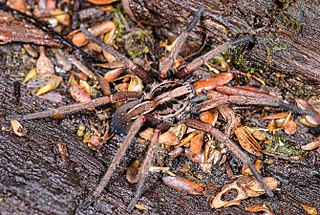
The Mygalomorphae, or mygalomorphs, are an infraorder of spiders, and comprise one of three major groups of living spiders with over 3000 species, found on all continents except Antarctica. Many members are known as trapdoor spiders due to their creation of trapdoors over their burrows. Other prominent groups include Australian funnel web spiders and tarantulas, with the latter accounting for around one third of all mygalomorphs.

The family Dipluridae, known as curtain-web spiders are a group of spiders in the infraorder Mygalomorphae, that have two pairs of booklungs, and chelicerae (fangs) that move up and down in a stabbing motion. A number of genera, including that of the Sydney funnel-web spider (Atrax), used to be classified in this family but have now been moved to Atracidae.

Atracidae is a family of mygalomorph spiders, commonly known as Australian funnel-web spiders or atracids. It has been included as a subfamily of the Hexathelidae, but is now recognized as a separate family. All members of the family are native to Australia. Atracidae consists of three genera: Atrax, Hadronyche, and Illawarra, comprising 35 species. Some members of the family produce venom that is dangerous to humans, and bites by spiders of six of the species have caused severe injuries to victims. The bites of the Sydney funnel-web spider and northern tree-dwelling funnel-web spider are potentially deadly, but no fatalities have occurred since the introduction of modern first-aid techniques and antivenom.

Nursery web spiders (Pisauridae) are a family of araneomorph spiders first described by Eugène Simon in 1890. Females of the family are known for building special nursery webs. When their eggs are about to hatch, a female spider builds a tent-like web, places her egg sac inside, and stands guard outside, hence the family's common name. Like wolf spiders, however, nursery web spiders are roaming hunters that don't use webs for catching prey.

Miturgidae is a family of araneomorph spiders that includes nearly 170 species in 29 genera worldwide. First described by Eugène Simon in 1886, it has been substantially revised, and includes the previous family Zoridae as a synonym, and excludes the family Xenoctenidae. Several genera have also been removed, such as the large genus Cheiracanthium, which was transferred to the Cheiracanthiidae.

Zoropsidae, also known as false wolf spiders for their physical similarity to wolf spiders, is a family of cribellate araneomorph spiders first described by Philipp Bertkau in 1882. They can be distinguished from wolf spiders by their two rows of eyes that are more equal in size than those of Lycosidae.
Plesiolena is a small genus of South American mygalomorph spiders in the family Actinopodidae. It was first described by Pablo A. Goloboff and Norman I. Platnick in 1987, and it has only been found in Chile. The name is a combination of "plesiomorphy" and the genus Missulena. As of November 2021 it contains only 2 species: P. bonneti and P. jorgelina.

Idiopidae, also known as armored or spiny trapdoor spiders, is a family of mygalomorph spiders first described by Eugène Simon in 1889.

Barychelidae, also known as brushed trapdoor spiders, is a spider family with about 300 species in 42 genera.

Migidae, also known as tree trapdoor spiders, is a family of spiders with about 100 species in eleven genera. They are small to large spiders with little to no hair and build burrows with a trapdoor. Some species live in tree fern stems. They have a Gondwanan distribution, found almost exclusively on the Southern Hemisphere, occurring in South America, Africa, Madagascar, Australia, New Zealand and New Caledonia.

Gradungulidae, also known as large-clawed spiders, is a spider family endemic to Australia and New Zealand. They are medium to large-sized haplogyne spiders with three claws and two pairs of book-lungs similar to Mygalomorphae. Some species build extensive webs with an upper retreat tangle and connecting threads to scaffolding. This supports the ladder-like catching platform that is glued to the ground. Progradungula, a large spider with long legs like Hickmania, and Macrogradungula are the only cribellate genera of the family.
Robert John Raven is an Australian arachnologist, being the Head of Terrestrial Biodiversity and the Senior Curator (Arachnida) at the Queensland Museum. Dr Raven has described many species of spider in Australia and elsewhere, and is spider bite consultant to the Royal Brisbane Hospital, leading to much work on spider toxins.
Caledothele is a genus of South Pacific spiders in the family Euagridae. It was first described by Robert Raven in 1991.
Cethegus is a genus of mygalomorph spiders in the curtain-web family Euagridae. It s endemic to Australia and was first described by Tamerlan Thorell in 1881.

Arkyidae is a family of araneomorph spiders first described by Ludwig Carl Christian Koch in 1872 as a subfamily of Araneidae, and later elevated to a full family in 2017.
Colcarteria is a genus of Australian intertidal spiders that was first described by Michael R. Gray in 1992. As of May 2019 it contains only three species: C. carrai, C. kempseyi, and C. yessabah.
Australothele is a genus of Australian spiders in the family Euagridae. It was first described by Robert Raven in 1984.
Namirea is a genus of Australian spiders in the family Euagridae. It was first described by Robert Raven in 1984.
Euagridae is a family of mygalomorph spiders. The group was first described as a tribe in 1979 by Robert Raven, who in 1985 elevated it to a subfamily. In 2020, Opatova et al. elevated it further to a family.










